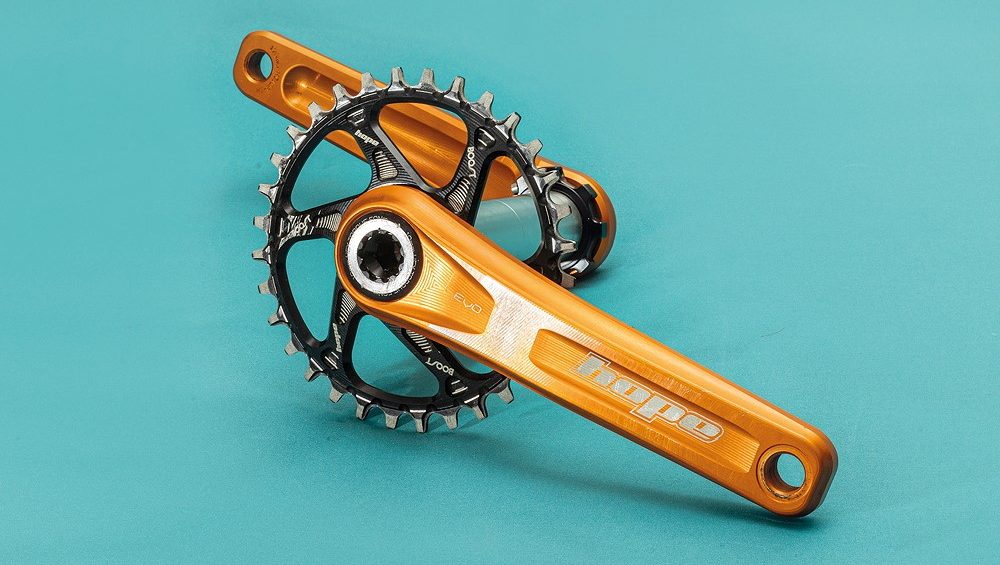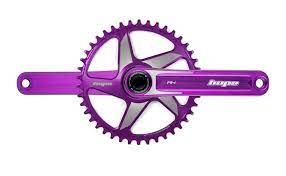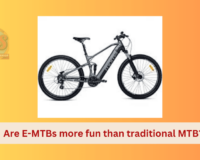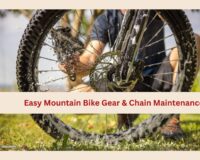The Crankset is quite simply, the part of your bike that allows you to convert the power produced by your legs into rotational motion that drives the bicycle forward. Hope Bike Cranksets are one of the most important parts of the bike that comes in a range of lengths, like handlebars and saddlers.
Thus, before buying Crankset it is important to know what crank length is right for you. Adding to the location of Cranksets, it is attached to the bike frame via the bottom bracket and connected by the chain to the rear cassette.
Talking about the Hope’s Cranksets, like another part of their bike these are also manufactured at their own factory in Barnoldswick, United Kingdom. Generally, they use a two-step manufacturing process to make the cranks.
The first one is the cranks are cold-forged from 7000 series aluminum to give them ultimate strength, before being CNC machined to remove material. Both of these processes can improve the crank and gives them that unmistakable Hope looks. Hope Technology is regarded to be a leading bike components manufacturer in the world. Hope’s style, quality, and components made Hope more popular.
To bring compatibility, stiffness people often upgrade their crankset. Choosing the right length and power meter option will be a great help for you to control your workouts as much as possible. The change in the crank usually depends upon the range, model, and material.
These things will give you a fresh start and can give you a weight saving of between 150 and 300 grams, or even more if you come from a set of basic range cranks. In the below pages we have done tremendous research regarding Hope’s Cranksets part, types, outer appearance and many more.
Types of Hope’s Bike Crankset
Hope Bike Crankset comes in great quality. They have (so far) been smooth, solid, and creak-free, and clearance is good. The three types of Hope’s Crankset are listed below. If you are confused about what to choose, it all depends upon you.
1. RX Crankset
The RX Crankset comes in 38, 40, 42, and 44 teeth (narrow/wide) sizes as an additional option. It is made especially for the gravel and tough trail. According to the makers, it is manufactured after their huge success on RX4 calipers and RS4 hubs. That why’s their name is also similar.
Highlighting the design, they’ve been relatively simple designs carved from single-billet setups with reasonable stiffness and weight. RX is their first hollow crank however; they are made up of two cold-forged and machined halves. Hollow is specially designed for the removal of any unwanted material increasing stiffness and reducing weight. It weighs around 518g and comes in 170, 172.5, and 175mm arm length.
Each part of this crank has tiny spacers and flow channels to help in the flow of bonding epoxy in and penetrates consistently through the whole structure. The epoxy is also hardened as they are machined again for a finish smooth look before being anodized into colors. You can get any colors (Black, Blue, Red, Silver, Purple, and Orange) RX Crankset.
As claimed by the maker, RX Crankset is directly compatible with almost every BB system, especially with direct mount chain rings. RX Crankset is proudly designed, manufactured, and tested in Barnoldswick, UK.
Overall, Hope has really come with a great RX. That delivers not only ring durability but also excellent bearing, easy fitting, and legendary factory back-up.
Purple Hope’s RX Crankset Credit: evocycles.co.uk
Price of the Hope’s RX Crankset
Compared to other bike brands’ Cranksets, Hope’s RX Crankset is quite expensive. It might cost you around 320-360 €. However, the quality of the crankset will be worth the money. As they are more durable, good-looking, and lightweight than other Crankset.
Technical Specifications: Hope RX road/gravel chain set
- Weight: 567g with 40T ring
- Arm lengths: 170, 172.5, 175mm
- Colors: Black, blue, red, silver, purple, and orange
- Material crank arms: 7050 aluminum
- Ring sizes: 38, 40, 42, and 44 tooth
- Crankshaft material: 7050 aluminum
- Price: £330
- Q factor: 149mm
- Aluminum axle: 30mm
2. Hope Evo Crankset
Hope has been doing chain sets for a while, but they’ve been moderately simple designs carved from single-billet setups with reasonable stiffness and weight. The Evo is one of the most popular cranksets that actually takes tech from their carbon construction department.
Evo crank arms are fabricated from Forged and machined 7150 aluminum and the husky 30mm spindle is 7150 alloy. Arms come in 166, 170, and 175mm lengths. Like another part of the Hope bike, this Crankset is also made in their own factory in Barnoldswick, UK.
They claimed that Evo Hope says this Evo is particularly designed for a broad range of mountain bike use. The crankset offers spindles for most mountain bike configurations out there, from XC through DH, including Super Boost and fat bike widths.
Orange color Hope’s Evo Crankset Credit: Mbr.co.uk.
How Evo is different than RX Crankset?
Compared to their first Hollow crank RX, it is lighter and stiffer. According to Hope, the new cranks are claimed to be 15 percent lighter and stiffer than before. The previously used collect-locking arrangement for the spindle interface needs some work. However, like their previous work, this time also went for a 30 mm spindle that in normal operation remains fixed to the non-drive-side crank arm.
Similarly, the portion of the crank arm is also a few millimeters shorter than most other aluminum cranks. It is about 8m shorter than a Race Face Next R crank with the boots installed. Meanwhile, from Shimano XT and XTR cranks, it is about 2mm short. Talking about its compatibility it goes with every range of bottom brackets and with most bottom bracket systems.
If you are wondering what colors are available? Then we will tell you can get Evo Crankset in six colors (black, blue, red, silver, purple, and orange). And the range of the axle lengths is also available. At about 540g in 165mm length, these cranks weigh a touch around 560 gm.
Range of axle length options available to accommodate most bikes from XC, DH, and FAT bikes, including a new Super Boost version. Similarly, it weighs around 560g, (170mm Inc axle). While riding on the heavier mud, riders might experience or hear crunchy-munchy sounds.
Meanwhile, there is no sound on dry rides. However, if you love riding or exploring new places, these sounds might not affect your performance.
Precisely detail of Hope Evo Crankset
- Intended use: A broad range of mountain bike use
- Material crank arms: 30mm oversize 7075 an aluminum alloy axle
- Crankshaft material: 7050 aluminum
- Crankshaft diameter: 30 mm
- Crank lengths: 165, 170, and 175mm
- Compatibility: Accommodate bikes from XC, DH, and FAT bikes, including a new Super Boost version
- Finish: 7150 series aluminum alloy crank arms
- Weight from: 560g
- Color: black, blue, red, silver, purple, and orange
- 15% lighter and stiffer than the previous model
Price of Evo Crankset
Hope has put a lot of effort into this popular crankset. Evo has set a new benchmark for aluminum MTB cranks. It comes in a great Combination of impressively tough aluminum alloy crank arms with a self-extracting axle/arm interface.
That makes the Spiderless Crankset stiffer than ever. Talking about the price of this Crankset, it cost around 242, 02 € to 250, 00 €. The cost includes shipping & Handling for shipment to Nepal.
Overall, Hope really has created a crank for all seasons here, even if it’s a little pricier than the competition. The machine is good-looking and gorgeous. They have done a great job with the laser-etched graphics on the arms as well.
3. Hope bike’ E-Bike Crank
After a few years of badgering, Hope technology has come with a new e-bike specific. After a huge success on the version of its impressive Evo crankset, this E-Bike arrives with shorter crank arms and a narrower Q-factor. Like other Hope cranks, E-bike is also proudly Designed, Tested, and Manufactured in Barnoldswick, UK.
Versatile Aluminium E-Bike Cranks are specifically designed for the latest breed of the mountain and maximum ground clearance. It also gives you a great adventurous off-road thrill, this fantastic component features rock-solid aluminum construction.
This newly, crankset has its own self-extracting system for easy fitting and removal. E-bike comes in 155mm and 165mm in length and weighs around 472g. It is available in different colors including silver, blue, black, orange, red, and purple.
According to the maker, E-bike is most suitable for Bosch gen 2/4 systems and Yamaha PW-X systems. They also added that this model is most suitable for Brose systems as well. It might come to help in a narrow Q-factor option on Bosch systems if there is adequate frame clearance.
 Black Hope E-bike Crankset Credit: wiggle.com
Black Hope E-bike Crankset Credit: wiggle.com
Technical specifications:
- Weight according to the manufacturer: 472g
- Intended use: ground clearance
- Material crank arms: aluminum 7150
- Crank length: 155mm and 165mm length
- Q-factor: Optimized
- Color crank arms: black, blue, red, silver, orange or purple
- Compatibility: Bosch gen 2/4 systems and Yamaha PW-X systems
- Material crank arms: aluminum 7150
Price of Hope E-bike Crankset
As long as crank arms are checked regularly for tightness they should last for years and years. Yes! It is also followed for the Hope Crankset as well. The remarkable Hope E-Bike Crankset is perfect for E-MTB use as it delivers outstanding smoothness and torque with every rotation. The price of the Hope E-bike crankset is around GBP £150.
Part of Bike Cranksets
In the UK people call chain sets meanwhile people in the USA call them cranksets. Whatever, they call them, the crankset is connected to the rider by the pedals, to the bike frame by the bottom bracket, and to the rear sprocket, cassette or freewheel via the chain. Chainsets consist of various parts, they are listed below:
1. Cranks
The pair of the cranks are usually connected with the bottom bracket axle to the pedals, which are mounted at 180°. Bike cranks can vary in length to accommodate different-sized riders and different types of cycling. The length of the crank is measured from the center of the pedal spindle to the center of the bottom bracket spindle or axle.
Basically, the larger bike uses a crank that is from 165 mm to 180 mm long in 2.5 mm increments. And the length of the common cranks is 170 mm crank. As we know that shorter legs use shorter cranks; those with longer legs, longer cranks. Select a crank length it might help you.
There are some manufacturers who make bike cranks that can be adjusted to different lengths. Cranks are usually made up of an aluminum alloy, titanium, carbon fiber, Chromoly steel, or some less expensive steel.
Compared to other cranks, Tabular cranks can be light and very strong. These tabular are usually found on BMX bikes and are slowly finding their way to mountain bikes. Most of the Hope’s Cranks are made up of Aluminum with too forged or cold forged. Thus, they cost a little higher than other cranks.
Hope’s cranks are then made by forging the main arms around a hard steel insert which is then withdrawn, leaving an internal void to save weight. After they are welded up before final machined.
2. Chainrings
Chainrings are commonly known as chain wheels or sprockets. The Chainrings are generally having teeth spaced to engage every link of the chain as it passes over. Hope’s chainrings come in a narrow or wide tooth profile that is designed to retain the chain without the need for a chain device.
This chainrings are made for cranksets. It helps to save weight without the need for a separate spider. The designed rings are available in Standard or Boost offset and have the ability to run a broader range of smaller chainring sizes.
The chainsets are compatible with 9spd, 10sp, 11spd, and 12spd set-ups. Apart from that Chainrings are available in sizes ranging from 30 to 36 teeth and in 6 standard colors. Chainrings are typically made from an aluminum alloy, titanium, steel, or carbon fiber.
To differentiate the cheap and expensive chainrings check the chainrings welded or riveted directly to the crank arm or spider. Because expensive sets have the chainrings bolted on so that they can be replaced if worn or damaged, or to provide different gearing.
3. Spider
Spider is another important part of Cranksets. Hope’s high-quality cranks are specifically engineered for MTB use as they offer increased stiffness for excellent pedal stroke performance. Hope’s cranks arm’s forged and CNC-machined 7150 series aluminum construction is immensely tough for handling sudden knocks and bumps.
Generally, spiders usually have 4 or 5 arms, although Hopes has a single model. This model features an incredibly versatile spline-mounted single spider/chainring system for ease of use.
Hope’s Cranksets at a glance
Since 1989, Hope Technology is a leading engineering bike components maker. Ian Weatherill and Simon Sharp have been pushing the industry forward through designing, testing, and manufacturing virtually all products in-house. After a huge contribution and decades of hard work, Hopes approach with their long-awaited crankset, more than five years since the firm teased a prototype of its design.
During the interview with Owner said, “We make it so it’s going to last, and you don’t want to get anything back through the door.” After many years of prototyping, I’m sure these will match up to Hope’s strict standards.
Hope’s team opinion straight from the CNC machinist’s mouth, he said
“Developed over many years the Hope crank has been designed using the latest FEA (Finite Element Analysis) tools and extensive multi discipline field testing. The cranks feature a unique expanding spline axle/arm interface (pat pending).
Previously, cranks using splines often used a taper to ensure a snug fit. These cranks worked fine the first time they were fitted to the axle, but once they’d been taken off and on a few times, the spline became worn, so they’d suffer from the inevitable movement and annoying creak. Hope felt there must be a better way.
After many years of testing, they think they’ve found it in the form of an expanding spline. The cranks are pulled onto a conventional spline, then a tapered plug is fitted inside the axle which can be tightened up each time the arm is refitted – giving a perfect fit every time.
Added to this Hope CNC machine the arms from forgings which gives them immense stiffness and strength. The arms also have a splinted mounting for spiders and direct mount sprockets giving excellent versatility. The cranks are compatible with the majority of bottom bracket systems via Hopes expanded range of bottom brackets.”
The newly designed crankset comes in a unique design. Maker’s aims that their crankset will consign the creaks and excessive movement sometimes associated with well-used cranks to the past. Their crankset instead is pulled onto a conventional spline and then secured by a tapered plug within the 30mm axle, allowing for adjustment to accommodate for wear.
In overall, the cranks look simple and easy to adjust. You can also fix your own crank’s arm by using the provided tool. To fix simply put the tapered inner bolt to spread the splinted axle into the interface, screw the outer bolt to hold everything in place, and use the washer/lockring to tension the bearings, easy.
How to install the hope crankset?
Before you start to inaugurate that crankset, make sure that every part of the crankset is available. After confirming check whether the preload nut on the non-drive side arm is fully twisted or not. Then initiate your procedure, first apply a thin coat of grease to the Axle.
That will lend a hand to overcome the creaks and then flip the non-drive side assembly into the bottom bracket from the non (left) drive side of the bike. While sliding those sides it is better to avoid a hammer.
After the flip, you can apply a thin layer of grease again on those shaft splines and slide them on the drive side assembly. Make sure that it’s oriented 180 degrees from the non-drive sidearm.
After that impel the crank and as the splines are engaged then you can screw in the supplied crankset assembly tool by hand or anything. Again use a 19 mm wrench to tighten the crankset assembly tool. Fix until cranks come to a solid stop against the shaft. Then you can detach the crankset assembly tool.
As it becomes tighter, apply a thin layer of grease to the tapered plug. Later twist a plug by hand first before using the crankset assembly tool before using the wrench. Then tighten the tapered plug by using a 19mm torque wrench to 70-75 N.m. Then put a thin layer of grease on the drive side shaft end cap.
Further, just squeeze the drive slightly the end cap with the help of the Allen key to 17-20 N.m. Similarly, confirm whether the preload screw is tense or not. If it is not then utilize your hand to preload by hand until it comes into getting in touch with the bottom bracket guard.
Then secure the preload nut pinch bolt by means of a 2.5 mm Allen key to 0.6-0.8 N.m. Next, test out for any side play, and that the cranks rotate liberally. Now you are good to exit for a slice.
Thus, after reviewing every part of Hope’s Crankset we can say they are more developed and better looking than before. With their process of cleaning, anodizing, and laser etching, the cranks help to become shinier.
The axle of the revised crankset is 30 splines and six slots machined into the end and have threads tapped internally. That was quite commendable. If you want to invest your money in something that lasts for the year then go for Hope Crankset. Yes, the durability, stiffness, and comfy of hope will shock you.








